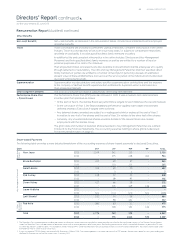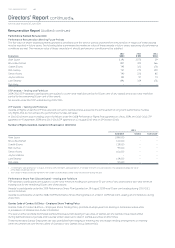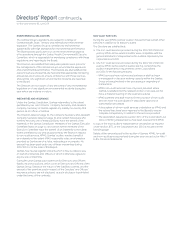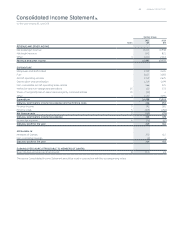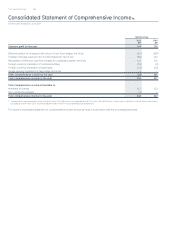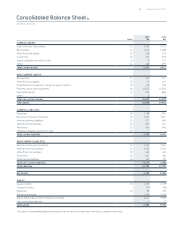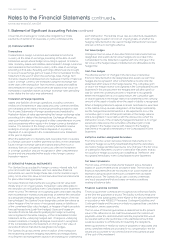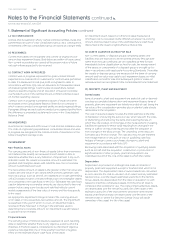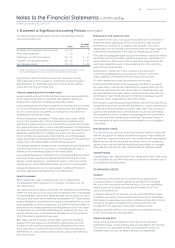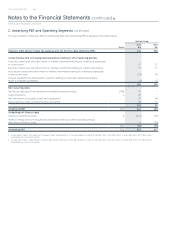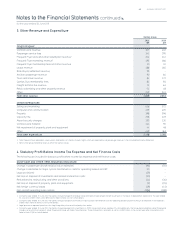Qantas 2011 Annual Report Download - page 57
Download and view the complete annual report
Please find page 57 of the 2011 Qantas annual report below. You can navigate through the pages in the report by either clicking on the pages listed below, or by using the keyword search tool below to find specific information within the annual report.
55 ANNUAL REPORT 2011
for the year ended 30 June 2011
Notes to the Financial Statements
1. Statement of Signicant Accounting Policies
Qantas Airways Limited (Qantas) is a company limited by shares,
incorporated in Australia whose shares are publicly traded on the
Australian Securities Exchange (ASX) and which is subject to the
operation of the Qantas Sale Act as described in the Corporate
Governance Statement.
The Consolidated Financial Statements for the year ended
June comprise Qantas and its controlled entities (together
referred to as the Qantas Group) and the Qantas Group’s interest
in associates and jointly controlled entities.
The Financial Statements of Qantas for the year ended June
were authorised for issue in accordance with a resolution of the
Directors on September .
A STATEMENT OF COMPLIANCE
The Consolidated Financial Statements are general purpose nancial
statements which have been prepared in accordance with Australian
Accounting Standards (AASBs) adopted by the Australian Accounting
Standards Board and the Corporations Act . The Consolidated
Financial Statements also comply with International Financial
Reporting Standards (IFRSs) and interpretations adopted by the
International Accounting Standards Board.
B BASIS OF PREPARATION
The Consolidated Financial Statements are presented in Australian
dollars and have been prepared on the basis of historical costs
except in accordance with relevant accounting policies where assets
and liabilities are stated at their fair values. Assets classied as held
for sale are stated at the lower of carrying amount and fair value less
costs to sell.
Qantas is a company of the kind referred to in Australian Securities
and Investments Commission (ASIC) Class Order / dated July
. In accordance with that Class Order, all nancial information
presented has been rounded to the nearest million dollars, unless
otherwise stated.
The accounting policies set out below have been consistently applied
to all periods presented in the Consolidated Financial Statements.
C CRITICAL ACCOUNTING ESTIMATES AND JUDGEMENTS
The preparation of the Consolidated Financial Statements in
conformity with AASBs requires management to make judgements,
estimates and assumptions that affect the application of accounting
policies and reported amounts of assets, liabilities, income and
expenses. The estimates and associated assumptions are based
on historical experience and various other factors that are believed
to be reasonable under the circumstances, the results of which form
the basis for making the judgements about carrying values of assets
and liabilities that are not readily apparent from other sources. Actual
results may differ from these estimates.
Estimates and underlying assumptions are reviewed on an ongoing
basis. Revisions to accounting estimates are recognised in the period
in which the estimate is revised and in any future periods affected.
Judgements made by management in the application of AASBs that
have a signicant effect on the Financial Statements and estimates
with a signicant risk of material adjustment in future periods are
highlighted below.
Change in Accounting Estimates – Passenger Aircraft Residual Value
From January the estimated residual values of passenger
aircraft were revised to between nil and per cent of acquisition
cost. The estimated residual values had been between nil and
per cent. These changes resulted in an increase in depreciation
expense of $ million (: $ million) for the year ended
June .
Change in Accounting Estimates – Major Cyclical Maintenance
Costs for Operating Leased Aircraft
Historically the costs of major cyclical maintenance checks for
operating leased aircraft were expensed as incurred, as the
difference from capitalising and depreciating these amounts over the
shorter of their useful life or the remaining lease term was immaterial.
During the year ended June the difference between
expensing the maintenance checks as incurred and capitalising/
depreciating became material due to the average age and resultant
maintenance prole of the operating leased aircraft. Therefore, from
July the Qantas Group has capitalised and depreciated the
costs of these checks over the shorter of their useful life or the
remaining lease term. Maintenance checks covered by third party
agreement where there is a transfer of risk and legal obligation
continue to be expensed on the basis of hours own. This aligns the
maintenance accounting for operating leased aircraft with owned
and nance leased aircraft.
This change resulted in $ million of maintenance costs being
capitalised in property, plant and equipment as at June
(net of depreciation). The effect of this change in the current year
prot and loss was an increase in depreciation expense of $ million
and a decrease in aircraft operating variable expense of $ million.
D PRINCIPLES OF CONSOLIDATION
Controlled Entities
Controlled entities are entities controlled by Qantas. Control exists
when Qantas has the power, directly or indirectly, to govern the
nancial and operating policies of an entity so as to obtain benets
from its activities. In assessing control, potential voting rights that
presently are exercisable or convertible are taken into account.
The Financial Statements of controlled entities are included in
the Consolidated Financial Statements from the date that control
commences until the date that control ceases.
Intra-group transactions, balances and unrealised gains and losses
on transactions between group companies are eliminated in
preparing the Consolidated Financial Statements.
Non-controlling interests in the results and equity of controlled
entities are shown separately in the Consolidated Income Statement,
Consolidated Statement of Comprehensive Income, Consolidated
Statement of Changes in Equity and Consolidated Balance Sheet.
Associates and Jointly Controlled Entities
Associates are those entities in which the Qantas Group has
signicant inuence, but not control or joint control, over the
nancial and operating policies.
Jointly controlled entities are those entities over whose activities the
Qantas Group has joint control, established by contractual agreement.
Investments in associates and jointly controlled entities are accounted
for using the equity accounting method. The investments are carried
at the lower of the equity accounted amount and the recoverable
amount.
The Qantas Group’s share of the associates’ and jointly controlled
entity’s post-acquisition prot or loss is recognised in the Consolidated
Income Statement from the date that signicant inuence or joint
control commences until the date that signicant inuence or joint
control ceases. The Qantas Group’s share of post-acquisition
movements in reserves is recognised in other comprehensive income.
The cumulative post-acquisition movements are adjusted against the
carrying value of the investment. Dividends reduce the carrying
amount of the equity accounted investment.
When the Qantas Group’s share of losses exceeds its equity
accounted carrying value of an associate or jointly controlled entity,
the Qantas Group’s carrying amount is reduced to nil and recognition
of further losses is discontinued, except to the extent that the Qantas


